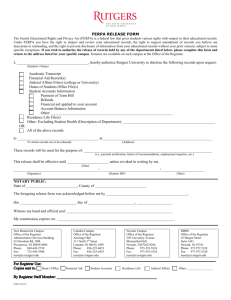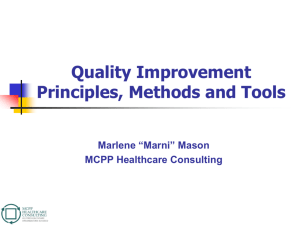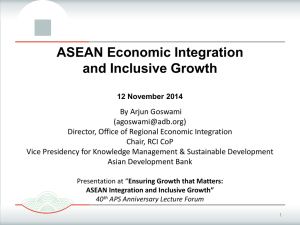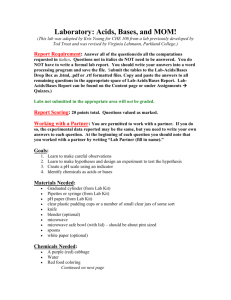PPT - Center for Software Engineering
advertisement
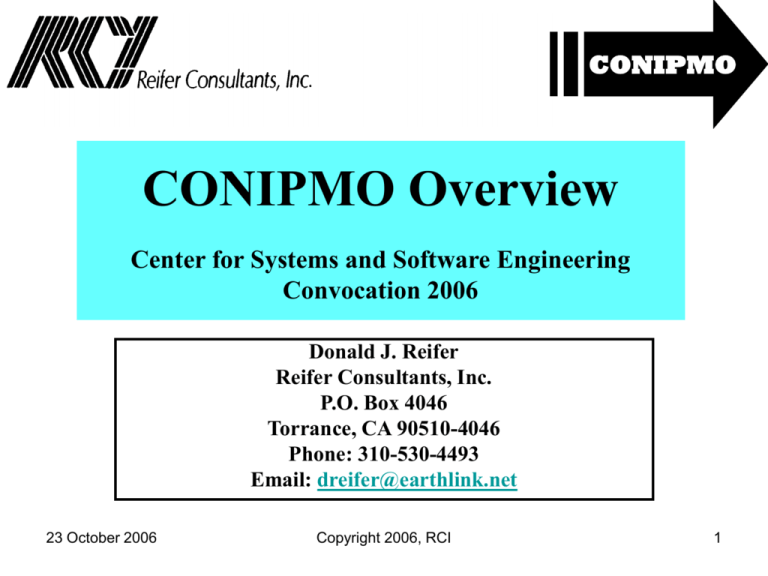
CONIPMO CONIPMO Overview Center for Systems and Software Engineering Convocation 2006 Donald J. Reifer Reifer Consultants, Inc. P.O. Box 4046 Torrance, CA 90510-4046 Phone: 310-530-4493 Email: dreifer@earthlink.net 23 October 2006 Copyright 2006, RCI 1 Introduction to CONIPMO • Parametric model to estimate engineering effort for developing network defenses – Anti-tamper is a subsidiary model • Sponsored by MDA and the Army under a Phase I SBIR – Phase II follow-on effort applied for - decision pending • Builds on COSYSMO effort (primarily sizing) – Includes 4 size and 12 cost drivers – Covers the full system engineering life cycle • Security experts from nine firms were involved in its development • Developed with USC-CSSE participation 23 October 2006 Copyright 2006, RCI 2 COSECMO/CONIPMO Differences COSECMO • Security extensions to COCOMO II • Entire life cycle • 4 years old • Variable granularity • Size increased, existing drivers adjusted and a new SECU driver added • Implementation guided by Common Criteria, Orange Book, etc. • Size is driven by SLOC 23 October 2006 CONIPMO • Security engineering • Entire life cycle • 1 year old • ~ 2 data points • 16 drivers • Fixed granularity • No anchor points • Size of network defense model is driven by equivalent no. of security requirements Copyright 2006, RCI 3 Network Security –At What Cost? DMZ Proxy Server Intrusion Prevention System SQL Server Firewall Router Servers Sniffer Gateway Gateway Defense-in-depth is a necessary, but expensive proposition requiring additional equipment and software to provide layers of protection against intruders, both insiders and outsiders. Costs need to be justified by the protection provided. 23 October 2006 Copyright 2006, RCI 4 Security Impact on Engineering Effort • For software developers: – Source lines of code increases – Effort to generate software increases • For systems engineers: – Effort to develop system increases • Network defense requirements • Network defense operational concepts • Program protection requirements • Anti-tamper implementation • Security functional requirements • Security assurance requirements – Effort to transition also increases • More documentation • Additional certification and accreditation costs Being addressed by COSECMO 23 October 2006 – Effort to transition also increases • DITSCAP and red teaming Being addressed by CONIPMO Copyright 2006, RCI 5 Goals Established for CONIPMO • Three primary goals for the effort were established using the GQM approach – Be able to generate an accurate estimate of the time and effort needed to secure the network infrastructure defenses – Be able to validate the estimate using actuals – Be able to predict the effort involved should anti-tamper be a requirement 23 October 2006 Copyright 2006, RCI Expert Collaborators Group Formed 6 CONIPMO Life Cycle Framework Conceptualize Develop OT&E 1. Requirements specification 2. Architecture development 3. Project planning 4. Product assessments 5. HW and SW acquisitions 6. Software development, integration & test 7. OT&E Heuristics model Parametric model Heuristic model Transition to Operations 8. Transition and turnover 9. DIACAP Operate, Maintain or Enhance Replace (or Dismantle) 10. Operations 11. Maintenance 12. Replace (or destroy) Program Protection Tasks (if required) 13. Program protection planning 14. HW and SW acquisitions 15. HW and SW modifications/ enhancements 16. Red teaming 17. Independent T&E 18. DIACAP 19. Maintenance 20. Destroy Heuristic model 23 October 2006 Copyright 2006, RCI 7 Relationship to Key SE Standards Process description ISO/IEC 15288 EIA/ANSI 632 High level practices Detailed practices Conceptualize IEEE 1220 Level of detail System life OT&E ------------- Develop Transition to Operation Operate, Maintain, or Enhance Replace or Dismantle Purpose of the Standards: ISO/IEC 15288 - Establish a common framework for describing the life cycle of systems EIA/ANSI 632 - Provide an integrated set of fundamental processes to aid a developer in the engineering or re-engineering of a system IEEE 1220 - Provide a standard for managing systems engineering 23 October 2006 Copyright 2006, RCI Source : Draft Report ISO Study Group May 2, 2000 8 WBS-Based Network Defense Model Network Defense Infrastructure Estimating Model Conceptualize See Slide 13 PM = Person Month CM = Calendar Month Development See Slide 13 Operational Test & Evaluation Effort OT&E (PM) = Effort function (no. of test scenarios required for acceptance) (PM) Transition to Operations Effort Turnover (PM) = Effort Transition (PM) + Effort DITSCAP (PM) Where: Effort Transition = Estimated Level-of-Effort based on available manpower Effort DITSCAP = Estimated Level-of-Effort based on past experience Duration OT&E (CM)= function (effort and available schedule time) Duration Turnover (CM) = Fixed at one year for transition and eighteen months for DIACAP Operate & Maintain Effort O&M (PM) = Effort Ops (PM) + Effort Maintenance (PM) Where: Effort Ops = Estimated Level-of-Effort based on budgeted manpower Effort Maintenance = Estimated using code fragment changed model + additional inputs to accommodate COTS packages + hardware repairs, updates and replacement + recertification costs Duration O&M (CM) = Fixed on a annual basis for operations and release plans for maintenance Replace (or Destroy) Effort Replace (PM) = Effort function (system size) (PM) + Effort Recertify (PM) Where: Effort Recertify = Estimated Level-of-Effort based on no. of requirements and availability of regression tests and test scripts Duration Replace (CM) = function (effort) and upgrade plans 23 October 2006 Copyright 2006, RCI 9 Rules of Thumb for Network Defense Model for Effort Estimation Life Cycle Phase Parameter Computed Operational Test & Evaluation Effort OT&E (PM) Rules of Thumb Effort Range = function (difficulty) Transition to Operations Effort DITSCAP (PM) Effort Range = function (difficulty) Replace (or Destroy) Effort f (system size)(PM) Effort Range = function (difficulty) Effort Recertify (PM) Effort Range = function (difficulty) 23 October 2006 Small Moderate Large 1 to 10 scenarios 11 to 25 scenarios Over 25 scenarios (assume that operational test & evaluation is highly automated) 4 to 6 PM 8 to 12 PM 18 to 24 PM Limited Average Self contained , little Some external external agency coordination, coordination, informal formal test and customer test and acceptance acceptance 8 to 12 PM 24 to 36 PM Extensive Lots of external coordination, tests witnessed by and very formal 48 to 60 PM Small Moderate Large < 1K requirements Between 1 and 10K > 10K requirements system requirements 6 to 8 PM 12 to 18 PM 18 to 24 PM Small Moderate Large < 10 tests 10 to 50 tests More than 50 tests (assume that recertification testing is highly automated) 4 to 6 PM 8 to 12 PM 18 to 24 PM Copyright 2006, RCI 10 Network Defense Early Phase Cost Model Size -No of requirements -No. of interfaces -No. of operational scenarios -No. of critical algorithms -No. of false alarms -+ Volatility Factor 12 Effort = A (B) ∏Di (Size) C i=1 Calibration Effort (PM) Duration (CM) Duration = Function (Effort) Where Effort = All hours to perform engineering tasks (requirements, architecture, development, test and integration; includes task management, in PM (152 hours/month)) A = Calibration constant See descriptions for cost B = Architecture constant (see Page 13) drivers on following pages C = Power law D i = Cost Drivers Where: ∏D i = product of their ratings Size = No. of weighted predictors scaled for a given false alarm rate Note: The model takes the form of a regression model. We are currently working with our collaborators to reduce the number of cost drivers to the set that captures the variations in effort as noted by our experts. The size drivers are taken from the COSYSMO model as representative of systems comprised of both hardware and software components. Acquisitions are excluded and their costs must be added to the estimates generated. 23 October 2006 Copyright 2006, RCI 11 Architectural Constant Architecture Constant (B): A constant used to adjust the model to reflect the following range of network defense requirements/architectures. Architecture Description Value No defenses Maybe a firewall, but that is it 1.22/1.25 Basic defenses Hardware firewall; router authorization; OS patches up-to-date; local authentication 1.11/1.10 Standard defenses Basic plus IDS; network scanner to identify intrusions; log files analyzed ; system swept to identify vulnerabilities Advanced defenses Standard plus DMZ configuration; IPS; layered defenses aimed at identifying and recovering from insider & outsider attacks 0.91/0.90 State-of-the-art defenses Advanced plus proxy server configuration; defense-indepth with active alerts on situation displays; honeypots for forensics 0.84/0.80 23 October 2006 Copyright 2006, RCI 1.00 12 Size Drivers (Network Defense) • No. of System Requirements – Represents the weighted number of network defense requirements in systemof-interest at a specific level of design. Requirements may be functional, performance, feature or service-oriented in nature depending on specification methodology. • No. of Major Interfaces – Represents the weighted number of shared major physical and logical boundaries between network defense system components or functions (internal interfaces) and those external to the system (external interfaces). • No. of Operational Scenarios – Represents the weighted number of operational scenarios that the network defense system must satisfy. Such threads typically result in end-to-end tests that are developed to validate the system satisfies all of its requirements. • No. of Critical Algorithms – Represents the weighted number of newly defined or significantly altered functions that require unique mathematical algorithms to be derived to achieve the network defense system performance requirements. 23 October 2006 Copyright 2006, RCI 13 Number of False Alarms • No. of False Alarms (quality normalization factor) – Sets the false alarm goal for the network defense system. This is the cumulative number of false alarms per day that are displayed on situational awareness consoles. – False alarm rate used as a weighting factor for the size driver summation. Size = (Weighting Factor) ∑ wi SD i Number of False Alarms Description Weighting Factor Very Low No. of false alarms less than one per day on average 0.75 Low No. of false alarms less than two per day on average 0.87/0.90 Nominal No. of false alarms between two and five per day during nominal traffic load on the network High No. of false alarms between five and eight per day on average 1.35/1.30 Very High No. of false alarms greater than eight per day 1.56/1.70 23 October 2006 Copyright 2006, RCI 1.00 14 Driver Definitions (Continued) • Number and Diversity of Vendor Products & Platforms/ Installations – Rates the ability to mount defenses based on the number of vendors products being used and platforms/installations that need to be defended. – Effort tends to increase non-linearly as number of vendors/platforms increases. • Personnel/Team Experience – Rates the capabilities and experience of the security team when implementing defenses similar to those being proposed for the network. • Process Capability – Rates the effectiveness and robustness of the processes used by the security team in establishing the network infrastructure defenses. • Requirements Complexity – Rates the precedentedness, difficulty and volatility of the overarching requirements established for network defense (common criteria assurance and functional levels, etc.). 23 October 2006 Copyright 2006, RCI 15 Driver Definitions (Completed) • Secure Facility Constraints – Rates the difficulty of performing work as a function of physical security constraints placed on the team implementing network security (cipher locks, guards, security processes, etc.). • Stakeholder Team Cohesion – Rates the degree of shared vision and cooperation exhibited by the different organizations working on security the network infrastructure (customer, developer, auditor, etc.). • Technology Maturity – Rates the relative maturity of the technology selected for use in the defense of the network using NASA’s Technology Readiness Levels. • Tools Support – Rates the coverage, integration and maturity of the tools used, both hardware and software, to mount network defenses (includes test automation for revalidating defenses once they are changed). 23 October 2006 Copyright 2006, RCI 16 EMR Results (Collaborator Group) Degree of Innovation ------------------------------------ 1.52 Migration Complexity -------------------------------------- 1.65 Secure Facility Constraints -------------------------------------- 1.65 No. and Diversity of Installations ---------------------------------------- 1.70 Process Capability ----------------------------------------- 1.78 Tools Support ------------------------------------------ 1.87 Requirements Complexity ------------------------------------------ 1.93 Architecture Understanding ------------------------------------------- 2.00 Stakeholder Team Cohesion -------------------------------------------- 2.06 Personnel/Team Experience --------------------------------------------- 2.07 Technology Maturity ---------------------------------------------------- 2.50 Level of Service Requirements ------------------------------------------------------- 2.72 0.0 23 October 2006 1.0 Copyright 2006, RCI 2.0 3.0 EMR 17 EMR Results (Delphi Round 1) Secure Facility Constraints ----------------------------- 1.27 Degree of Innovation ---------------------------------- 1.49 No. and Diversity of Installations ------------------------------------ 1.60 Technology Maturity ------------------------------------- 1.65 Tools Support -------------------------------------- 1.75 Migration Complexity --------------------------------------- 1.83 Process Capability ------------------------------------------- 1.93 Stakeholder Team Cohesion ------------------------------------------- 1.94 Architecture Understanding ------------------------------------------- 1.95 Requirements Complexity --------------------------------------------- 2.04 Level of Service Requirements ------------------------------------------------------------ 2.87 Personnel/Team Experience ------------------------------------------------------------- 2.92 0.0 23 October 2006 1.0 Copyright 2006, RCI 2.0 3.0 EMR 18 Anti-Tamper Early Phase Cost Model Size - No. of function or feature points (see IFPUG for definitions) 11 Effort = A ∏ D i (Size) C i =1 Effort (PM) Duration (CM) Calibration Where Effort = all hours to perform engineering tasks in PM (152 hours/month) A = calibration constant C = power law ∏ D i = product of their ratings D i = cost drivers (see amplifying description for each of the drivers) Size = effective size of the application being protected 23 October 2006 Copyright 2006, RCI 19 Candidate Cost Drivers for AntiTamper Early Phase Cost Model Cost Drivers • Architecture Complexity • Process Capability • Degree of Ceremony • Requirements Complexity • Depth and Breadth of Protection Requirements (in PPP) • Stakeholder Team Cohesion • Level of Service Requirements • Technology Maturity • Number and Diversity of Platforms/ Installations • Tools Support (for protection) • Personnel/Team Experience 23 October 2006 Copyright 2006, RCI 20 AT Unique Cost Drivers • Degree of Ceremony – Rates the formality in which the team operates during development, testing, red teaming and DITSCAP certification. Ratings are a function of support that needs to be provided along with documentation. • Depth and Breadth of Protection Requirements – Rates the breadth and depth of protection required in terms of how much protection, both hardware and software, must be mechanized to satisfy the requirements in the Program Protection Plan. • Tool Support (for protection) – Rates the degree of coverage, integration and maturity of the tools used, both hardware and software, to mechanize protection (includes the test automation available for revalidating protection once the defenses are changed for whatever reason). 23 October 2006 Copyright 2006, RCI 21 EMR Results (Collaborators Group) EMR values differ slightly for AT Early Estimation Model Migration Complexity -------------------------------------- 1.65 Process Capability ----------------------------------------- 1.78 Tools Support ------------------------------------------ 1.90 Requirements Complexity ------------------------------------------ 1.93 Architecture Understanding ------------------------------------------- 2.00 Depth & Breadth of Requirements -------------------------------------------- 2.05 Stakeholder Team Cohesion --------------------------------------------- 2.06 Degree of Ceremony ---------------------------------------------- 2.17 Personnel/Team Experience ------------------------------------------------- 2.37 Technology Maturity ---------------------------------------------------- 2.50 Level of Service Requirements --------------------------------------------------------- 2.85 0.0 23 October 2006 1.0 Copyright 2006, RCI 2.0 3.0 EMR 22 EMR Results (Round 1 Delphi) EMR values differ slightly for AT Early Estimation Model No. and Diversity of Platforms --------------------------------------- 1.70 Tools Support --------------------------------------- 1.77 Process Capability ----------------------------------------- 1.79 Requirements Complexity ------------------------------------------ 1.89 Architecture Understanding -------------------------------------------- 2.13 Degree of Ceremony --------------------------------------------- 2.13 Technology Maturity ------------------------------------------------- 2.20 Stakeholder Team Cohesion -------------------------------------------------- 2.33 Level of Service Requirements --------------------------------------------------------- 2.67 Depth & Breadth of Requirements ------------------------------------------------------------------------- 3.25 Personnel/Team Experience -------------------------------------------------------------------------- 3.25 0.0 23 October 2006 1.0 Copyright 2006, RCI 2.0 3.0 EMR 23 USC CONIPMO • USC CS577 project – Two semester course – Six person software development team – Two person IV&V team located remotely – Visual Basic package with “touch & feel” of the current USC COCOMO II package – Will have lots of features including a self-calibration mode 23 October 2006 Copyright 2006, RCI 24 Next Steps – CY2006-7 Schedule Task 3rd Quarter 4th Quarter Model Development 1. Define drivers 2. Rate drivers via Delphi Update 1st Quarter 2nd Quarter START PHASE II CONTRACT 3. Develop counting rules 4. Develop model definition manual 5. Build prototype model 6. Calibrate prototype model Data Collection 1. Develop data collection questionnaire 2. Test questionnaire utility via trial use 3. Capture data 4. Build Excel database 5. Statistically analyze data 6. Calibrate model and its parameters 23 October 2006 NOW Copyright 2006, RCI 25 Issues Raised in Delphi • Many security products used commercially are COTS – Security must be included as an integral part of the COTS selection, tailoring and integration processes • Security team part of systems effort and not separable – Only separable effort the security certification and accreditation (C&A) activity (normally part of DIACAP) – May need to look at different teams doing security work (e.g., engineering, operational and certification teams) – Hard to determine percent effort and schedule • Number of platforms a function of number of sites the system deployed – May want to consider this a size rather than cost driver 23 October 2006 Copyright 2006, RCI 26 More Issues Raised in Delphi • Process capability should address the certification and accreditation team as well as systems engineering personnel – Must report pass/fail status of each of 110+ MAC-1 controls • Technology maturity is viewed negatively for security because maturity infers vulnerabilities • Size driver definitions need to be clearer especially in terms of the impacts of interfaces and operational scenarios • False alarms is a good normalization factor to use for the model • Anti-tamper model should be kept separate because it is addressed by different teams – Typically driven by protection and not security requirements – Trying to protect loss of intellectual property via reverse engineering 23 October 2006 Copyright 2006, RCI 27 Past and Present CONIPMO Players • Delphi participants – – – – – – – – – • Letters of endorsement Aerospace Galorath, Inc. General Dynamics Lockheed Martin MIT Northrop Grumman Sentar, Inc. Teledyne Solutions, Inc. USC 23 October 2006 – Army Space & Missile Defense Future Warfare Center (SMDC/FWC) – Naval Underwater Warfare Center (NUWC) – Net-Centric Certification Office (DISA) – MDA/Ground Midcourse Defense (GMD) Element – Galorath, Inc. – Lockheed Martin Copyright 2006, RCI 28 Future Needs/Challenges • Getting people to talk, share ideas, provide data and collaborate – Often close-mouthed due to classification issues • • Access to real data for use in validating model Winning a Phase II support – Must acquire a steady stream of funds for several years of data collection 23 October 2006 Copyright 2006, RCI 29 Questions or Comments • Donald J. Reifer dreifer@earthlink.net Phone: 310-530-4493 When eating an elephant take one bite at a time. ………Creighton Adams An elephant is a mouse built to Mil-Spec. ……….Sayings Galore 23 October 2006 Copyright 2006, RCI 30

